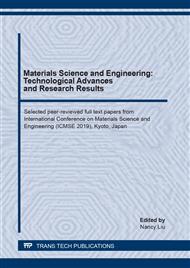[1]
McKenna J K, Erki M A. Strengthening of reinforced concrete flexural members using externally applied steel plates and fibre composite sheets-a survey. Canadian Journal of Civil Engineering, 1994, 21(1): 16-24.
DOI: 10.1139/l94-002
Google Scholar
[2]
Sebastian W M. Significance of midspan debonding failure in FRP-plated concrete beams. Journal of Structural Engineering, 2001, 127(7): 792-798.
DOI: 10.1061/(asce)0733-9445(2001)127:7(792)
Google Scholar
[3]
Van Gemert D.A. Repairing of concrete structures by externally bonded steel plates. Developments in Civil Engineering,1982,5: 519-526.
Google Scholar
[4]
Sharma S, Mohamed Ali M, Goldar Detal. Plate-concrete interfacial bond strength of PRP and metallic plated concrete specimens. Composites, PartB: Engineering, 2006, 37(1):54-63.
DOI: 10.1016/j.compositesb.2005.05.011
Google Scholar
[5]
Lu Xinzheng. Studies on FRP-Concrete Interface. Tsinghua University, 2004. (in chinese).
Google Scholar
[6]
Dai J,Ueda T,Sato Y. Development of the nonlinear bond stress-slip model of fiber reinforced plastics sheet-concrete interfaces with a simple method. Journal of Composites for Construction, ASCE, 2005,9(1):52-62.
DOI: 10.1061/(asce)1090-0268(2005)9:1(52)
Google Scholar
[7]
Yamaguchi I. A laser-speckle strain gauge. Journal of Physics(E),1981, 14(5):1270-1273.
Google Scholar
[8]
Peters W H, Ranson W F. Digital Imaging Techniques in Experimental Stress Analysis. Optical Engineering, 1982,21(3):427-431.
Google Scholar
[9]
Yao Jian, Teng Jinguang. Experimental study on bond strength between FRP and concrete. Journal of Building Structures,2003,24 (5):10-18.
Google Scholar
[10]
Ali-Ahmad M, Subramaniam K, Ghosn M. Experimental investigation and fracture analysis of debonding between concrete and FRP sheets. Journal of engineering mechanics, 2006, 132(9): 914-923.
DOI: 10.1061/(asce)0733-9399(2006)132:9(914)
Google Scholar
[11]
Lu X Z, Teng J G, Ye L P, et al. Bond–slip models for FRP sheets/plates bonded to concrete. Engineering structures, 2005, 27(6): 920-937. (in chinese).
DOI: 10.1016/j.engstruct.2005.01.014
Google Scholar
[12]
YUAN H, WU Z, YOSHIZAWA H. Theoretical solutions on interfacial stress transfer of externally bonded steel/composite laminates. Journal of Structural Mechanics and Earthquake Engineering, JSCE,2001,675/1-55,27-39.
DOI: 10.2208/jscej.2001.675_27
Google Scholar
[13]
Chen J F, Teng J G. Anchorage strength models for FRP and steel plates bonded to concrete. Journal of Structural Engineering, 2001, 127(7): 784-791.
DOI: 10.1061/(asce)0733-9445(2001)127:7(784)
Google Scholar


